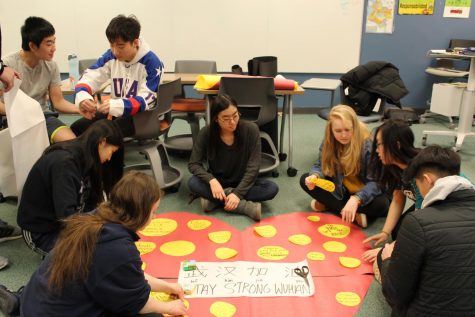Coronavirus project created to spread awareness
Editor’s note: This article was written during the week of March 1, 2020, prior to the start of Glenbrook High School District #225 E-Learning and subsequent developments in the ongoing COVID-19 pandemic. The information included in this article is up to date as of March 1, and will remain as is in order to preserve the historical context of this time period and to show how rapidly the pandemic has been changing.

Photo by Elaine Kim
When junior Leon Chen heard jokes and racist comments around school targeted towards Asian people due to the recent outbreak of the coronavirus, he reacted by laughing, despite feeling hurt.
“I have family [in Wuhan, China],” said Chen. “I know [the racism] doesn’t really come from a place to hurt people, but making this wall will really show … that it can.”
Chinese teacher Wanyin Chou said she had the idea for her 4-5A Chinese class to create a wall to spread awareness about the virus after learning about a similar project at Stevenson High School. She heard about the project at Stevenson through a social messaging platform called WeChat, which is commonly used in China and by Chinese teachers internationally.
Along with spreading awareness, the wall aims to combat racism towards the Asian community, said Chou. The wall is planned to diminish racism by displaying statistics and encouraging messages addressed to Wuhan, where the virus was initially discovered.
According to Chou, she has seen Asian kids cough, and then heard other kids make “nasty comments” towards them. Chou said she gets nervous when she goes out in public now because she is Asian and does not know what others think of her.
William Schaffner, infectious disease specialist at Vanderbilt University, said in a phone interview that the coronavirus is a respiratory virus that mainly affects the throat, bronchial tubes and lungs.
“[When] people are close together for prolonged periods of time in enclosed spaces, … those are circumstances in which the virus can be transmitted very readily,” Schaffner said.
Common symptoms include sore throat, fever, coughing and sneezing. When the virus begins to affect the lung tissue, an indication is difficulty breathing, said Schaffner.
“Many countries … ended travel between China and their countries,” said Schaffner. “The obvious reason for that [travel ban] is to make sure that people who’ve been in China, whether they’re citizens of China or citizens of other countries, don’t go to other countries and bring the virus with them.”
According to senior Evie Kelly, who took on many of the leadership roles in the project, the plan for the wall is to include a red heart with yellow bubbles containing facts about the virus. The class has arranged for some of the bubbles to be larger than others, depending on what information the class considers important.
The class also wants to put a white banner on the wall that says “You are fighting well, Wuhan” in Chinese, Kelly said. The class planned to put the mural on the windows across from the bookstore for the month following spring break, but due to the cancelation of school because of the outbreak, a date for the wall’s set up is currently unknown.
Even though she believes stereotypes and racist comments are not as common at Glenbrook North, her class wanted to focus the wall on educating others about those who are affected by the disease to avoid racial stereotyping, Kelly said.
“Our goal is to spread awareness … not only about the virus itself, but awareness about how it’s [affecting] Asian students here at GBN,” Kelly said.

